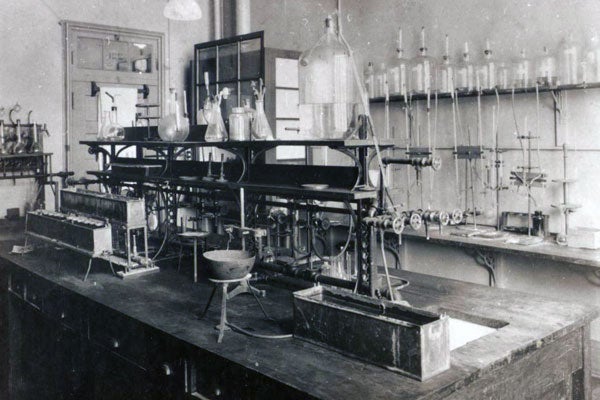
Why did U of T name its entrepreneurship hub after Banting and Best?
Published: April 27, 2015
They saved lives here at home and around the world and they launched the first cohort of entrepreneurs at the University of Toronto – in 1923.
“Banting wasn’t an entrepreneur. Best wasn’t an entrepreneur. But the emergence of insulin really was an example of entrepreneurship at the University of Toronto,” says Michael Bliss, historian and author of The Discovery of Insulin.
The Nobel Prize-winning discovery of insulin by Frederick Banting and Charles Best remains one of the most significant research achievements by the labs at U of T. And the drug is still saving the lives of diabetics around the world today because those researchers commercialized their discovery, says Bliss.
“It wasn’t just Banting and Best at all: it involved a whole team’s determination to take a fundamental laboratory discovery and turn it into a commercial product. They did it by working in collaboration.”
Today, U of T’s ecosystem for startups includes nine customized accelerators and a growing network of entrepreneurship courses, programs, office space and more – all brought together by the Banting & Best Centre for Innovation & Entrepreneurship.
 “That same atmosphere of collaboration and support seen through the development of insulin is what student entrepreneurs get when they’re in any one of our incubators or accelerators,” says Karen Sievewright, director of the Banting & Best Centre (pictured at right).
“That same atmosphere of collaboration and support seen through the development of insulin is what student entrepreneurs get when they’re in any one of our incubators or accelerators,” says Karen Sievewright, director of the Banting & Best Centre (pictured at right).
“Our young scientists and entrepreneurs get access to professors who have deep knowledge; they get access to mentors and investors who have the practical expertise to implement things. It’s the same concept as what happened with Banting and Best and we are excited to see how we can help today’s entrepreneurs make their mark in the same way.”
OTI Lumionics is just one of the startups that chose to locate its headquarters at the BBCIE.
The company offers a low-cost system for producing organic LED lighting – thin, light and flexible “green” lighting solutions with applications for interior design, architecture, medical devices and commercial products such as their aerelight lamp. Built on U of T research, OTI Lumionics was developed through various U of T entrepreneurship supports brought together by the BBCIE.
“The location of the Banting and Best Centre – allowing us to get such a large space, and space that’s suitable for research in downtown Toronto – is fantastic,” says Michael Helander, chief executive officer of OTI Lumionics.
“You can turn graduate research into successful startups. It can be done in Canada, you don’t have to go all the way down to Silicon Valley or outside the country,” says Helander, describing the “ecosystem and community of mentors, advisors and investors that are all either U of T alumni or associated with the university in one way or another.”
OTI Lumionics began as graduate research at U of T. The company developed with help from the BBCIE’s elite Creative Destruction Lab accelerator program and, after graduating, leased office space at the BBCIE.
“There are many entrepreneurship opportunities at the university that are open to students, to young people, to faculty,” says Sievewright. “We’ll help you way-find through the ecosystem.”
With an upwards trend towards startups and entrepreneurship in the changing North American economy, many universities now offer entrepreneurship support. But, Bliss notes, U of T’s experience launching insulin made it one of the first.
“It’s hard to think of another North American university that had so much success commercializing a product for the next half-century,” says Bliss. “U of T was pioneering in that regard.”
Fast forward to 2014 – Cynthia Goh is a professor of chemistry and a modern-day pioneer of entrepreneurship at U of T. She was featured by the Globe and Mail in their ‘risk takers’ series as they recounted her experience co-founding six startups. Goh also created the successful Entrepreneurship 101 series more than 10 years ago, which quickly outgrew the department of chemistry and is now offered by MaRS. She also directs the Impact Centre at the BBCIE. Tailored to helping researchers from the natural sciences and engineering learn the skills of entrepreneurship, the Impact Centre was U of T's first accelerator program.
“Insulin was not just a research triumph, it is the most important commercialization to have happened at U of T,” said Goh. “In a few short years insulin went from brilliant research to saving lives, to commercial success and a Nobel Prize. What better example of a commercialized university discovery could we ask for?”
Brianna Goldberg writes about entrepreneurship and produces The Cities Podcast for U of T News.



